Staying on Track with Your 2025 Budget: Businesses face the continued challenge of managing expenses, ensuring profitability, and staying within budget. Sticking to a budget is critical to maintaining financial health and long-term success. While creating a budget is often seen as the first step, the real challenge lies in following it through the year. This article explores the key strategies for sticking to your budget in 2025, highlighting the importance of planning, monitoring expenses, and adjusting as needed.
Creating a Realistic Budget
The first step in sticking to a budget is crafting a realistic and flexible plan. A budget should reflect your business’s actual financial situation and future goals, providing a clear view of expected revenues and costs. Start by categorizing all potential expenses, including fixed costs like rent, salaries, and utilities, as well as variable expenses such as marketing, supplies, and travel. Understanding the seasonal fluctuations in sales and expenditures will also help in forecasting the cash flow more accurately.
A successful budget isn’t simply about limiting spending; it’s about allocating resources effectively to meet the organization’s needs. Be sure to build in contingencies for unexpected costs, such as equipment breakdowns or market shifts, and plan for growth-related investments like expanding product lines or increasing staff. Having a realistic and adaptable budget creates a solid financial framework and sets clear boundaries for decision-making, helping the business stay on course throughout the year.
Tracking and Monitoring Expenses
Once your staying on track with your 2025 budget is established, continuous monitoring is essential to staying on track. Regularly reviewing expenses allows you to spot discrepancies or areas where costs may be creeping beyond planned limits. It’s important to create a system for tracking expenditures, whether through accounting software, spreadsheets, or a third-party service. These tools can help you categorize spending, reconcile transactions, and generate reports that highlight variances from the original budget.
One of the most effective ways to manage expenses is by setting up alerts or thresholds for each category. This can involve setting automatic reminders when a particular expense category exceeds a set percentage of the planned budget. Additionally, scheduling regular check-ins with the finance team or department managers will ensure that everyone is aware of where the company stands financially. This proactive approach can help mitigate the risk of overspending and enable swift adjustments if necessary.
Evaluating Logistics and Supply Chain Expenses
In many businesses, the logistics cost represents a significant portion of the overall budget. These costs include shipping, inventory management, storage, and distribution. Efficient management of logistics is essential for staying within budget, as even small increases in logistics costs can add up quickly and disrupt financial planning.
To control logistics costs, businesses should look for ways to optimize their supply chain. This could involve renegotiating contracts with suppliers to reduce shipping fees, consolidating shipments to take advantage of bulk discounts, or exploring more cost-effective distribution methods. Additionally, reviewing inventory management practices can prevent overstocking, which ties up capital, and understocking, which leads to last-minute rush orders and higher shipping costs. By focusing on these areas, businesses can reduce logistics expenses and ensure that they are not eating into the budget allocated for other critical functions.
Building a Culture of Financial Discipline
Ultimately, sticking to your 2025 budget requires building a culture of financial discipline throughout the organization. Involve employees and department heads in the budgeting process, ensuring that everyone understands the importance of staying on track. By encouraging accountability and fostering an understanding of how each department contributes to the overall budget, businesses can ensure more mindful spending decisions across the board.
Regular financial training, setting clear expectations, and rewarding cost-conscious behavior can further help maintain focus on budget adherence. By creating a shared commitment to financial success, businesses can better manage their expenses and position themselves for sustainable growth.
Conclusion
Staying on Track with Your 2025 Budget: Successfully sticking to a budget in 2025 requires a combination of strategic planning, continuous monitoring, and adaptability. By creating a realistic budget, prioritizing key activities, managing cash flow effectively, and optimizing logistics expenses, businesses can stay on course financially. Regular reviews and the flexibility to adjust as circumstances change will further enhance the ability to maintain financial discipline. With the right strategies in place, businesses can ensure that they are not only sticking to their budget but also laying the foundation for long-term success.
If you enjoyed this article and would like to read more like it, please check out the rest of our blog today.
